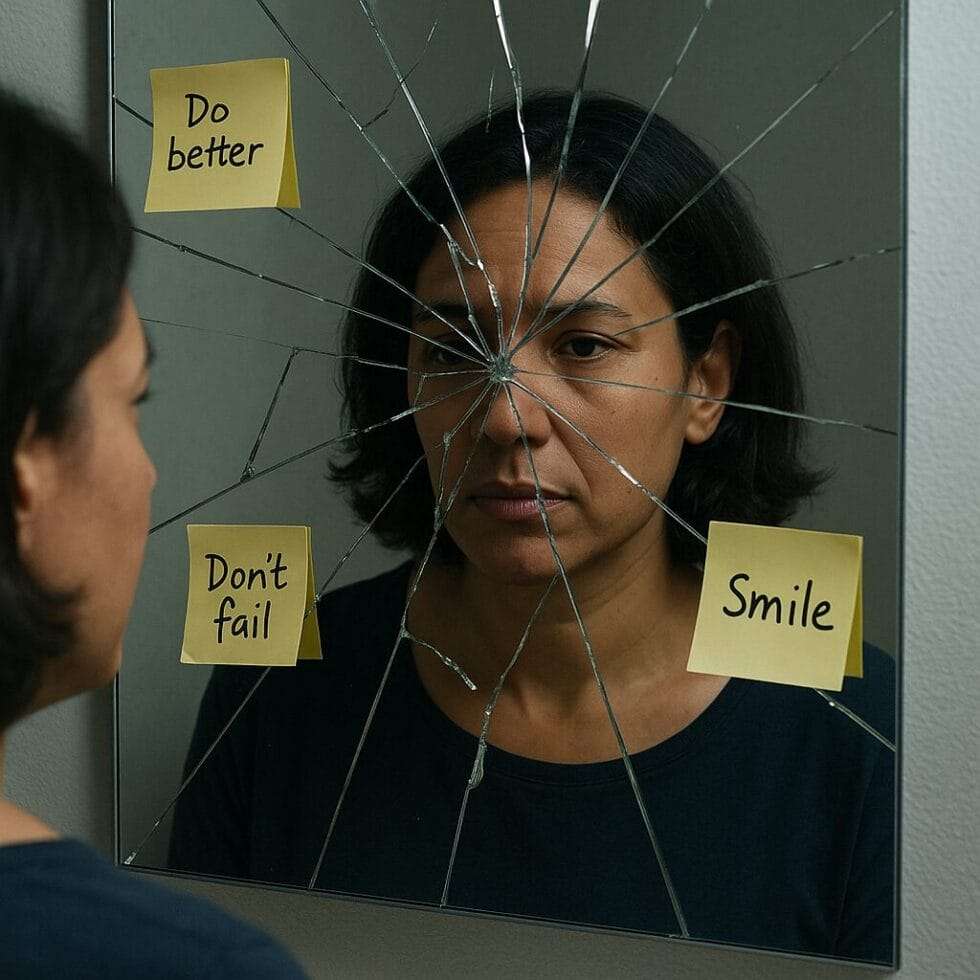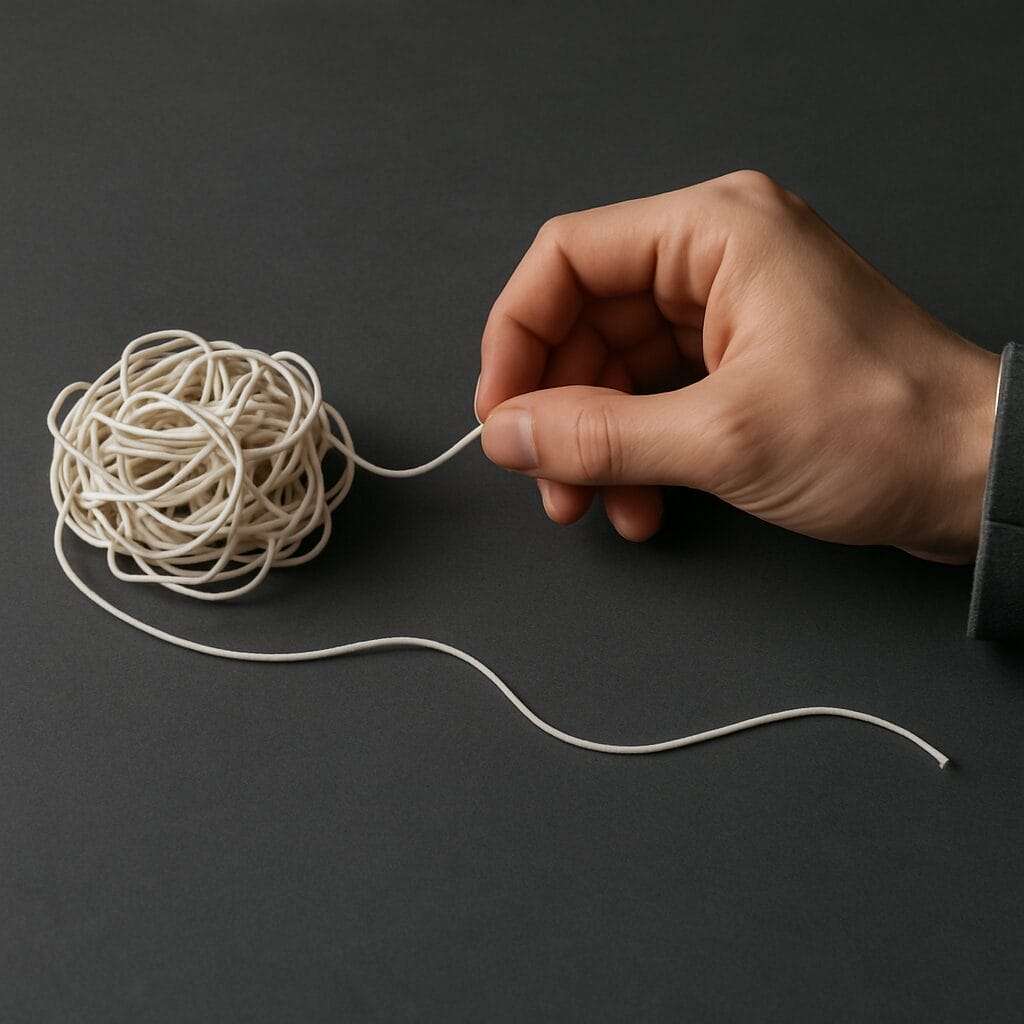
Self-Sabotage Is a Survival Pattern: Here’s How to Break the Cycle
- Published:
- Updated: July 24, 2025
Ever catch yourself doing the very thing you swore you’d outgrow?
The late-night email frenzy. The endless scrolling instead of sleeping. The “I’ll rest when I earn it” mantra that leaves you running on fumes.
Here’s the truth: you’re not failing.
You’re a high-functioning leader who’s still running survival scripts—patterns that were wired long before you had a corner office, a client roster, or a team looking to you for clarity.
These maladaptive patterns—procrastination, over-control, isolation, emotional numbing—aren’t signs of weakness. They’re the coping strategies that once helped you survive chaos or criticism.
But now? They’re costing you energy, trust, and connection.
This isn’t about surface-level “habits.”
This is about rewriting the unconscious loops that keep you performing when you should be leading—and thriving.
In this post, we’ll break down six patterns that quietly hijack even the most capable people, where they come from, and how to start dismantling them for good.
Steps to Unwinding the Pattern Loop
What Are Maladaptive Patterns—Really?
Maladaptive patterns are emotional and behavioral loops we developed to survive tough situations—usually long before we had any real choice in the matter.
They’re built on coping strategies: unconscious habits designed to keep us safe, avoid conflict, or navigate chaos.
A coping strategy might look like shutting down when tension rises, over-delivering to avoid rejection, or making yourself small to keep the peace. At the time, these responses made sense—they were protective.
But over time, they turn into reflexes that keep us stuck.
Here’s the truth:
Nobody sets out to sabotage their own life.
What once helped you survive can become the very thing that sabotages your growth, relationships, and leadership. Naming these patterns isn’t about shame—it’s about clarity. Because once you see the loop, you can step out of it.

Example: Rachel’s Story
Rachel grew up in a fiercely competitive household. Her mother, Danielle, praised kids who brought home perfect grades—and humiliated the ones who didn’t. A “C” was treated like a capital offense.
So Rachel learned to hustle, outperform, and never let her guard down—because her sense of safety depended on it.
Fast forward to adulthood: Rachel is a high-functioning professional, but she’s chronically anxious, hypercritical of others, and miserable in team settings.
What once protected her—perfectionism and workaholism—has become a wall.
Her story isn’t rare. Many of us are still following rules written in childhood—and wondering why our adult lives feel so tense.
I unpack those dynamics in:
How Parents Shape Our Patterns (Without Knowing It)
Our earliest relationships form the emotional blueprint we carry into adulthood. Most maladaptive patterns begin in childhood—not because someone set out to damage us, but because everyone was surviving the best way they knew how.
Your parents weren’t villains. They were humans with their own unhealed scripts, doing what they could to keep the family afloat.
You didn’t inherit their pain by choice—you simply picked up where they left off.

Think about it:
A mother who criticizes her son or tries to control every move may not be cruel—she might be acting from the unresolved resentment or fear she felt toward her own partner.
A father who withholds affection from his daughter might be mirroring the way he was raised—believing toughness equals love.
The son doesn’t learn healthy masculinity—he learns to either shut down or lash out indirectly.
The daughter doesn’t learn secure attachment—she learns to chase validation or overcorrect by becoming fiercely independent.
This isn’t about blame.
It’s about recognition. When you see the script clearly, you stop reenacting it. You gain choice. You build your own language of connection—one that isn’t rooted in survival.
Yes, it’s very important for people to understand that.
— MJ (@TaoOfMJ) July 26, 2023
When I’m not at my best when parenting my daughter, I will tell her where I made mistakes and apologize to her.
I want her to be able to say sorry when she is in the wrong. The other half of the coparenting duo still has…
6 Maladaptive Loops High-Performers Can’t Afford to Ignore
These patterns aren’t flaws—they’re old survival strategies. Let’s look at each in detail.

1. The High-Performer’s Escape Hatch: Productivity, People, and Painkillers
You don’t need a bottle to check out—you have your inbox, your calendar, your endless to-do list.
Work is your socially acceptable drug.
But if you’re honest, you’re not just “driven.” You’re running. Chasing relief. And the quiet feels unbearable without something to fix or someone to save.
2. Aggression in Disguise: When ‘Polite’ Leaders Bleed Resentment
You’re not throwing chairs in the boardroom, but the sting is there—hidden in the clipped Slack messages, the meetings that run on tension, the “it’s fine” laced with venom.
This isn’t leadership. It’s a slow leak of rage you’ve learned to mask because being direct once got you burned.
3. Strategic Delay—or Fear in a Power Suit?
You call it “planning.”
You call it “waiting for the right moment.”
But the truth? You’re terrified of getting it wrong.
So you tweak, polish, and stall—while the thing you say you want is suffocating under your perfectionism.
4. When Food Becomes Your Quiet Boardroom
It’s not about hunger. It’s about control.
You starve when you want to feel strong.
You binge when you want to feel anything.
Food has become your most loyal board member—the one that doesn’t ask questions, just nods while you try to swallow feelings you can’t name.
5. The CEO of Loneliness: Why You Keep Everyone at Arm’s Length
You say you value independence.
But the truth? You don’t know how to let people close without losing control.
So you keep your world curated—Zoom calls, polite surface-level chats, and a calendar so packed it never leaves room for someone to see the real you.
6. Scrolling for Relief: The Newest (and Most Socially Acceptable) Numb-Out
You pick up your phone like it’s a reflex. A meeting ends. The silence hits. And suddenly you’re deep in LinkedIn updates, news feeds, or “just one more” podcast clip.
It’s not curiosity. It’s escape. Because God forbid you sit with that gnawing restlessness for even a minute.
Read this post: Social Media is Hijacking Your Focus
Steps to Unwinding the Pattern Loop (Without Self-Sabotage)
Let’s cut through the noise: you can’t “out-think” your way out of survival mode. These patterns have teeth. They’re wired into your nervous system—and they don’t break just because you read a motivational quote or download a habit tracker.
But you can dismantle them, piece by piece. Here’s how:

1. Name the Pattern Without Dressing It Up
Stop calling procrastination “strategic patience” or rage “just passion.”
High performers love to rebrand their pain as productivity—but that’s just avoidance with a new logo. Naming the behavior honestly is step one.
2. Track the Trigger, Not Just the Behavior
Ask yourself: “What happens right before I slip into this pattern?”
Is it a hard conversation you’re avoiding? A fear of being seen as weak? The moment you can see what lights the fuse, you can stop blaming the fire.
3. Break the Loop with Micro-Defiance
Forget the overnight transformation myth. The real work is in micro-defiance—tiny, deliberate acts that disrupt the autopilot.
Instead of overworking? Close the laptop for 10 minutes and sit with the panic.
Instead of emotional eating? Ask, “What am I really hungry for?” and write down the first answer that comes to mind.
Instead of doomscrolling? Put the phone down and let the boredom sting. It’s where the truth lives.
4. Replace Control with Curiosity
Leaders love control. But control is a shield, not a solution. When the urge to “manage” everything spikes, shift into curiosity:
“What if I let this be messy? What am I afraid will happen?”
5. Build a Feedback Loop You Don’t Dodge
You can’t outgrow these patterns in a vacuum. Whether it’s a coach, a therapist, or a trusted peer who calls you on your excuses, get someone who holds the mirror steady when you want to look away.
6. Lead Yourself First
You want to build trust with your team, your clients, your family? Start by building it with yourself. Every time you choose truth over numbing, connection over isolation, or courage over avoidance—you lead. And they see it, even if you don’t.
You’re Not Broken—You’re Rewriting Your Leadership Script
High performers love to diagnose themselves as “broken” when the truth is simpler:
You’re not broken. You’re just running on old code.
The late nights, the self-critique, the quiet numbing—they were never random. They were survival tools.
But survival doesn’t scale. Not in business. Not in relationships. And not in the life you actually want to live.
Rewriting these patterns isn’t about perfection. It’s about choosing presence over performance.
It’s noticing when the old reflex kicks in, pausing long enough to ask, “What’s really running me right now—and what would leadership look like instead?”
If this hits home, it’s because you’re ready.
Not to grind harder. Not to “fix” yourself.
But to lead from a place that’s clean—free from the loops that have been calling the shots.
Here’s what to do next:
🎙️ Listen to the podcast – Real-talk episodes on healing, leadership, and emotional sobriety (especially for business owners and change-makers)
💌 Write me a note – I read every message. If something stirred in you, I’d be honored to hear it
🤝 Explore working together – If you’re ready for deeper clarity and emotional support
You don’t have to rush this season.
You don’t have to pretend it’s easy.
And you definitely don’t have to do it alone.
You’re doing sacred work.
Let that be enough—for now. 💛





